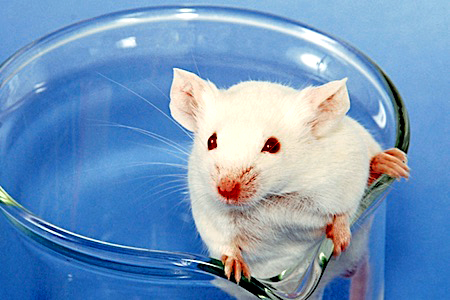 What special properties make the NOG mouse such a great acceptor of foreign cells and tissues? To answer this question, one need only look at the mouse line's name.
What special properties make the NOG mouse such a great acceptor of foreign cells and tissues? To answer this question, one need only look at the mouse line's name. NOD.Cg-Prkdcscid Il2rgtm1Sug/JicTac (NOG) mice are the product of decades of research and the sequential intercrossing of three independent mouse strains: the NOD mouse, the scid mouse and a targeted mutation of the interleukin 2 (IL-2) receptor-γ chain (IL2rg). All of these uniquely contribute to the enhanced engraftment properties of the NOG mouse.
NOD/Shi Mice
NOD is short for non-obese diabetic. The NOD mouse was introduced in the early 1980s by Shionogi Pharmaceuticals. Although these mice harbor mutations that confer a predisposition to Type 1 diabetes, they also express a unique polymorphic variant of the signal regulatory protein alpha (SIRPα). SIRPα is a protein expressed on macrophages that interacts with CD47 on the surface of cells to communicate a "don't eat me" signal.The variant of SIRPα found in NOD mice has high affinity for human CD47, which helps engrafted cells of human origin evade being engulfed by the host macrophages. Other mouse strains, such as C57BL/6 and BALB/c, express alternative variants of SIRPα with lower affinity for human CD47. In these strains, macrophages more readily recognize introduced human cells as foreign, leading to higher rates of graft rejection.
Scid and NOD scid Mice
Scid mice are the result of a recessive mutation in the Prkdc gene that renders the DNA dependent protein kinase enzyme ineffective. Because of this deficiency, VDJ recombination does not occur, resulting in failed development of T and B lymphocytes. In the early 1990s, mating strategies that combined NOD and scid phenotypes were performed to investigate the role of certain immune cells in diabetes.NOD scid mice have macrophages that are permissive to human cells and are immunodeficient from their lack of lymphoid-derived T cells and B cells. These mice were initially generated to examine mechanisms of Type 1 diabetes, a phenotype that was eliminated in the NOD scid background due to lack of functional T cells. A short time later, investigators expanded the use of NOD scid mice into hematopoietic stem cell engraftment investigations.
Improving NOD scid Mice Through Targeted Mutation of IL-2rg
A high incidence of thymic lymphoma was an early-observed drawback to the NOD scid mouse model. The combined backgrounds, while lacking functional B and T cells, were permissive over time to the uncontrolled expansion of T cells. This resulted in nearly 70% of all animals developing thymic lymphomas by 40 weeks of age.A second block to lymphoid cell development was introduced to NOD scid mice in the late 1990s and prevented the onset of thymic lymphomas. This second block was the result of crossing NOD scid mice with mice lacking the signaling component of the common IL-2rg subunit.
The IL-2rg subunit confers an important signaling component to several cytokine receptors through which signals are necessary for immune cell lineage development. T cell development is strictly dependent on IL-7 signaling in the thymus and thus, the disruption of a functional IL-2rg completely attenuated T lymphocyte cell expansion and prevented thymic lymphoma formation in NOD/scid/IL-2rg (i.e. NOG) mice. Moreover, the IL-2rg chain is required for IL-15 signaling; another growth factor required for natural killer (NK) cell development.
The CIEA NOG mouse® is ideal for human cell and tissue engraftment because it combines important properties originating from the NOD background, the spontaneous scid mutation and the targeted disruption of IL-2rg.
In combination, these traits produce a host with macrophages that are permissive to human cells and block lymphoid cell and NK cell development. Taken together, the resultant mouse is much longer lived, more tolerant of all types of xenograft tissue than their NOD scid predecessors, and uniquely suited for human hematopoietic stem cell engraftment.
















.jpg)

.jpg)
.jpg)
.jpg)
.jpg)





.jpg)


.jpg)
.jpg)




.jpg)




.jpg)

.jpg)





